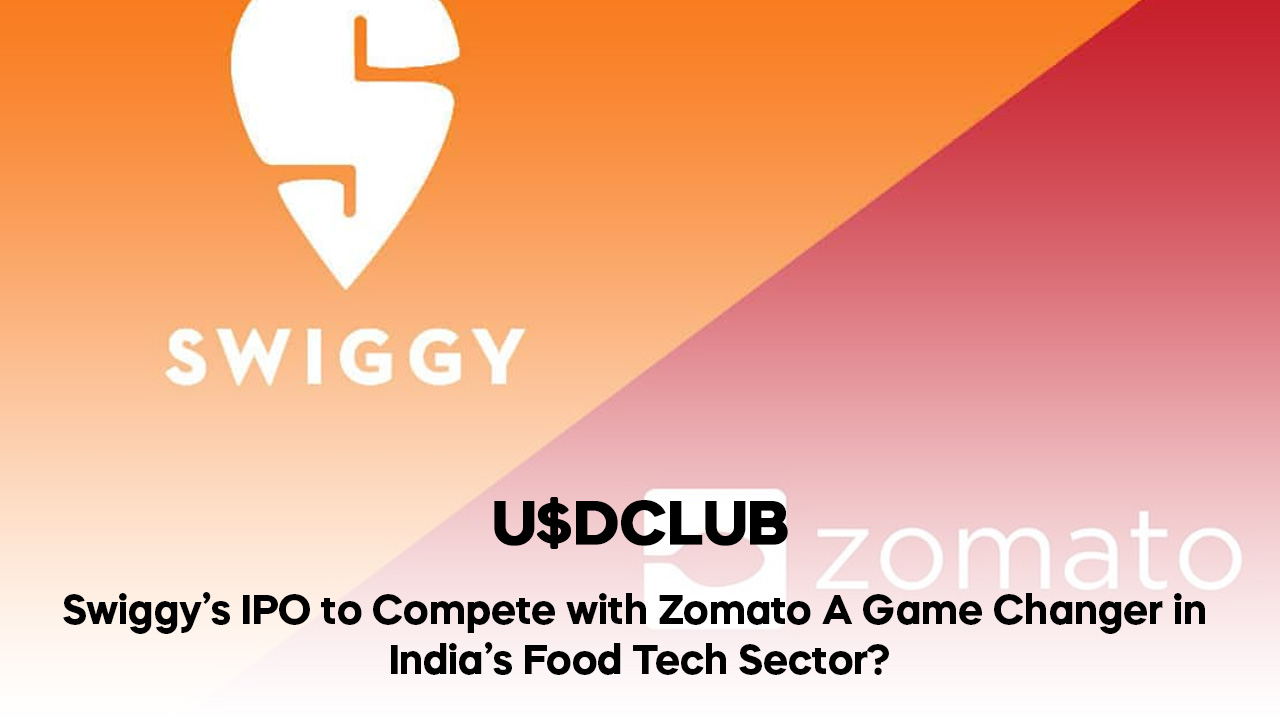Swiggy, one of India’s largest food delivery platforms, is gearing up to launch its highly anticipated Initial Public Offering (IPO), a strategic move that could significantly alter the dynamics of the food tech sector. Swiggy has officially filed an updated Draft Red Herring Prospectus (DRHP) with the *Securities and Exchange Board of India (SEBI), with plans to raise a whopping *₹11,000 crore** through this offering. This development positions Swiggy as a serious contender against its rival, Zomato, which has been the dominant player in the Indian food delivery market since going public in 2021.
This article explores Swiggy’s IPO journey, financials, and growth prospects, while delving into how it plans to leverage the capital raised through this offering to compete with Zomato. Will Swiggy’s IPO allow it to outshine Zomato, or will the competition only intensify as both giants vie for dominance in India’s rapidly expanding food tech industry?
The Scale and Scope of Swiggy’s IPO
Swiggy’s IPO is expected to be one of the largest public offerings in the Indian stock market in 2024. According to the latest DRHP filed with SEBI, the company plans to raise *₹11,000 crore* through its IPO, with *₹3,750 crore* being raised via fresh issue. This fresh capital infusion is expected to help Swiggy strengthen its balance sheet and fund its expansion plans. Additionally, *existing shareholders* are set to sell *185.3 million shares* in the IPO, allowing early investors to liquidate their holdings partially.
The company is targeting a valuation of *₹83,365 crore, a figure that would make Swiggy the **second-largest company in the food tech sector*, right behind Zomato. The IPO proceeds will likely be used to fund business operations, improve delivery infrastructure, bolster technology development, and expand Swiggy’s other verticals such as grocery and convenience delivery, which are rapidly gaining traction.
Financial Performance: Growth Amid Losses
Swiggy’s financial performance over the past few years highlights both its growth potential and the challenges it faces. In *FY24, the company reported a revenue of *₹11,247 crore*, a notable increase from the *₹8,264 crore** it reported in the previous year. This revenue growth signifies Swiggy’s increasing market penetration and its ability to capture a larger share of the food delivery market. However, like many other tech-driven platforms, Swiggy continues to operate at a loss.
In *FY24, Swiggy posted a loss of *₹2,350 crore*, a significant improvement compared to the *₹4,179 crore** loss it recorded in *FY23*. While the narrowing of losses is a positive sign, it underscores the fact that Swiggy, like its competitor Zomato, is still grappling with the high costs associated with customer acquisition, delivery infrastructure, and technological innovation.
However, Swiggy’s leadership has indicated that the company is on the path to profitability. The IPO could provide Swiggy with the necessary funds to accelerate this journey, allowing it to focus on improving operational efficiency, enhancing customer retention, and expanding its service offerings beyond food delivery.
Swiggy vs. Zomato: The Battle for Supremacy
The rivalry between Swiggy and Zomato has been one of the defining narratives of India’s food tech industry. Since Zomato’s IPO in *2021, the company has been the first publicly traded player in the Indian food delivery space, giving it a competitive edge in terms of access to capital. Zomato’s market valuation has hovered around *₹80,000 crore** to *₹90,000 crore*, with the company reporting substantial growth in revenue while also narrowing its losses.
Swiggy, on the other hand, has been privately held until now, limiting its ability to raise capital as quickly or efficiently as Zomato. However, with its upcoming IPO, Swiggy is poised to level the playing field. If successful, Swiggy’s IPO will not only provide it with access to public markets but also allow it to compete head-to-head with Zomato for market dominance.
Factors Favoring Swiggy’s Growth
-
*Diversification Beyond Food Delivery*
While Zomato has largely focused on food delivery and dining out services, Swiggy has diversified its offerings into adjacent sectors such as *grocery delivery* (through Swiggy Instamart) and *convenience delivery* (through Swiggy Genie). The company’s ability to deliver essential items, groceries, and more has given it a competitive advantage, especially during the pandemic, when demand for home delivery of groceries surged.
-
*Operational Efficiency*
Swiggy has invested heavily in its technology and delivery infrastructure, which allows it to optimize delivery routes, reduce delivery times, and enhance the overall customer experience. This focus on operational efficiency has helped Swiggy capture a loyal customer base in urban areas, where demand for fast and reliable delivery is high.
-
*Tier-II and Tier-III City Expansion*
Swiggy has aggressively expanded into *tier-II and tier-III cities* in India, tapping into a previously underpenetrated market. By doing so, the company has significantly expanded its user base, helping it grow its revenue while also achieving economies of scale.
-
*Loyalty Programs*
Swiggy’s *Swiggy One* subscription program, which offers benefits such as free deliveries and discounts on food and grocery orders, has gained popularity among users. These loyalty programs help Swiggy retain customers, reduce churn rates, and drive repeat orders, contributing to its revenue growth.
Challenges and Risks
While Swiggy’s IPO is highly anticipated, the company faces several challenges that could affect its long-term growth and profitability.
-
*Competition with Zomato*
Zomato is Swiggy’s primary competitor, and it already has a head start in the public markets. Zomato has successfully diversified its revenue streams, including launching a grocery delivery service in partnership with *Blinkit*. The intense competition between the two platforms has led to a race for customer acquisition, which can drive up marketing and promotional expenses for both companies.
-
*Profitability Concerns*
Like many startups in the food tech space, Swiggy operates on thin margins and faces challenges in achieving profitability. The food delivery industry is notorious for its high costs, which include delivery personnel wages, marketing, customer acquisition, and restaurant partnerships. While Swiggy has reduced its losses, achieving profitability remains a critical goal.
-
*Regulatory and Legal Risks*
As Swiggy goes public, it will need to navigate the complex regulatory landscape in India. The Indian government has introduced various regulations aimed at safeguarding customer data, ensuring fair competition, and protecting workers in the gig economy. Any changes in regulations could impact Swiggy’s business model and operational costs.
-
*Supply Chain and Inflation*
Supply chain disruptions and inflationary pressures could impact Swiggy’s profitability. Rising fuel costs, increased wages for delivery workers, and inflation in food prices could raise operating costs, making it more difficult for Swiggy to maintain low delivery fees and competitive pricing.
The IPO’s Impact on the Indian Food Tech Industry
Swiggy’s IPO could significantly impact the Indian food tech industry, which has witnessed exponential growth over the past decade. According to industry estimates, the food delivery market in India is expected to grow at a *compound annual growth rate (CAGR)* of *12-15%* over the next five years, driven by increasing internet penetration, smartphone usage, and a growing urban middle class.
With both Swiggy and Zomato publicly traded, investors will have the opportunity to gain exposure to two of India’s largest food delivery platforms. This competition is likely to foster innovation, improve service offerings, and lead to consolidation within the sector as smaller players struggle to keep up.
Furthermore, Swiggy’s IPO could pave the way for other startups in the food tech and gig economy sectors to consider going public, unlocking new opportunities for growth and investment.
Conclusion: Will Swiggy Leave Zomato Behind?
Swiggy’s IPO marks a significant milestone in its journey to becoming a leading player in the Indian food tech industry. The company’s aggressive expansion into new markets, diversification into grocery delivery, and focus on operational efficiency make it well-positioned to compete with Zomato. However, the road ahead is not without challenges. Swiggy will need to manage its profitability, navigate regulatory risks, and continue to innovate to stay ahead of the competition.
Whether Swiggy will be able to surpass Zomato remains to be seen, but the upcoming IPO certainly sets the stage for an exciting new chapter in the Indian food delivery space. As the market evolves, both companies will need to adapt to changing consumer preferences, technological advancements, and competitive pressures.
For investors and market watchers, the Swiggy-Zomato rivalry offers a fascinating glimpse into the future of India’s digital economy, where tech-driven platforms are reshaping traditional industries and creating new opportunities for growth.
For more updates on the latest developments in the financial markets and insightful investment strategies, *stay tuned to USDCLUB.us*, where we provide timely news and analysis from the world of finance.







